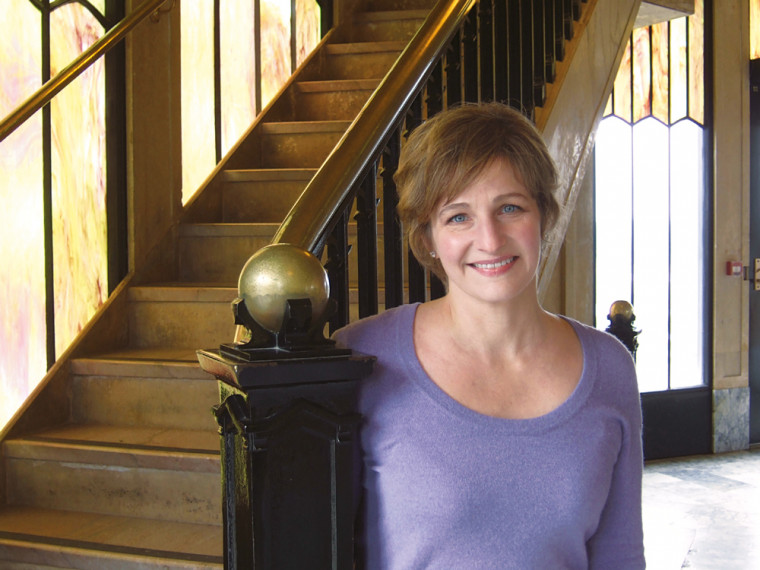Preserving Oregon’s Historic Landmarks
Open gallery

In the attic of historic Arlington House, located in Virginia’s Arlington National Cemetery, Chrissy Curran BA ’87 looked up in awe as her tour guide pointed out the name and date carved in a ceiling beam. A carpenter who’d helped build the house in the late 1700s had signed his work.
“I’ll never forget that moment, that visceral connection with craft and history,” says Curran, who was then a junior at Lewis & Clark and attending the college’s off-campus study program in New York. “Everything shifted for me. I knew without a doubt that I wanted to explore and preserve historic structures. I made up my mind and never looked back.”
Curran’s passion eventually led her to the Oregon State Historic Preservation Office in Salem, where she’s an associate deputy and architectural historian. She comanages the state’s Heritage Programs and oversees projects involving the National Register of Historic Places, environmental compliance, and federal and state tax incentives. Her office, established in 1967, has been instrumental in preserving places like Mount Hood’s Timberline Lodge, Oregon’s State Capitol, and Lewis & Clark’s Frank Manor House and gardens, as well as the Bonneville Dam, coastal lighthouses and bridges, and historic districts throughout the state.
I knew without a doubt that I wanted to explore and preserve historic structures. I made up my mind and never looked back.Chrissy Curran BA ’87
Curran’s job involves educating and providing resources to city planners, local governments, and individuals. She helps them identify historically significant structures and develop strategic preservation plans.
“Often people expect us to be the history police,” she says. “We can’t stop a demolition at the 11th hour or force cities to take better care of their buildings. We don’t have that kind of authority.”
Instead, her office helps connect constituents with helpful resources. For example, by tapping into certified local government funds, communities can keep an architect on retainer who offers “building doctor” services to owners. These architects can write a “prescription” for repair and rehabilitation and help communities prioritize projects.
The entire process starts with the National Register of Historic Places. To qualify, a building must have been an important part of a town’s culture and history—like the first grocery store or library, or a grange that represents a distinct agricultural movement. “Structures must be at least 50 years old to qualify, so many modern buildings can now be considered,” says Curran.
Looking back, she’s been preparing for the work she does almost all her life. “I’ve been drawing since I was 3 years old,” she says.
These landmarks are nonrenewable resources. Like old-growth trees, once they’re gone, they’ll never come back. Chrissy Curran BA ’87
That natural affinity for art brought her to Lewis & Clark, where she majored in art and minored in history. She credits the mentorship of Stewart Buettner, professor emeritus of art history, and Stephen Beckham, Pamplin Professor of History, as significant in shaping her focus. “They taught me how to write and how to conduct research,” she says. “That always put me ahead of my peers in competitive situations.”
After college, Curran tried out a few different work environments, including the Portland Art Museum and advertising agency Weiden+Kennedy.
“I took a big leap of faith in my late 20s, leaving my full-time job and heading to graduate school to study historic preservation at the University of Oregon,” she says. “Many of my friends were getting married and starting families, and I was starting over.”
Her gamble paid off. “During my career, I’ve been in the most amazing spaces,” she says. “I love the smell of old houses. I love historic building materials. I love doing research and learning the histories of structures and the people who built them.”
Curran is passionate about her work and adamant about the value of historic preservation. “It’s disheartening when we lose places that are important to us because someone didn’t understand the process,” she says. “These landmarks are nonrenewable resources. Like old-growth trees, once they’re gone, they’ll never come back.”
—by Pattie Pace
More L&C Magazine Stories
Lewis & Clark Magazine is located in McAfee on the Undergraduate Campus.
MSC: 19
email magazine@lclark.edu
voice 503-768-7970
fax 503-768-7969
The L&C Magazine staff welcomes letters and emails from readers about topics covered in the magazine. Correspondence must include your name and location and may be edited.
Lewis & Clark Magazine
Lewis & Clark
615 S. Palatine Hill Road MSC 19
Portland OR 97219

